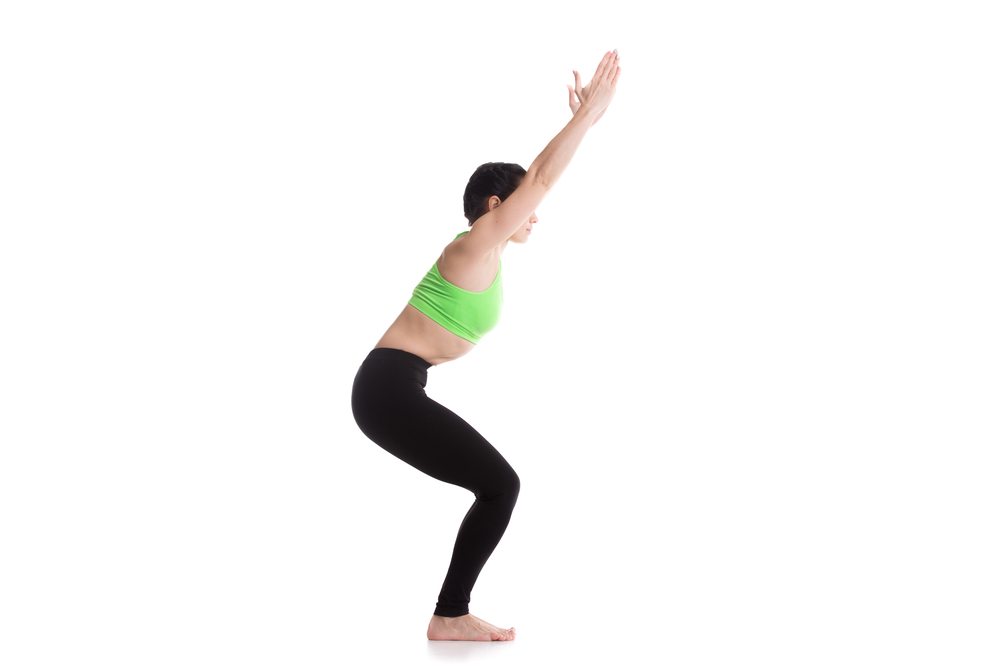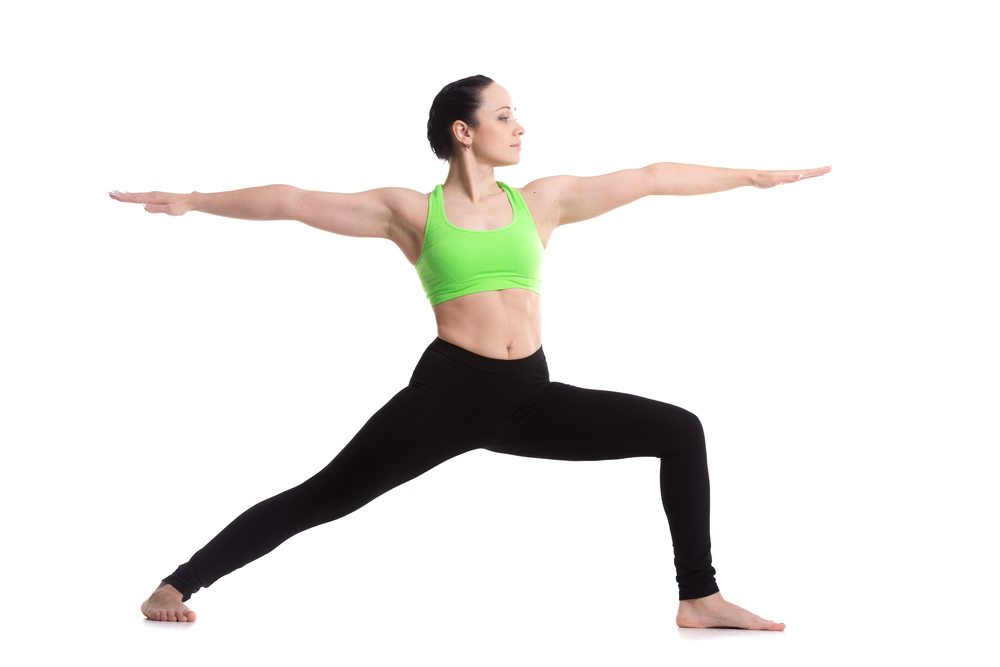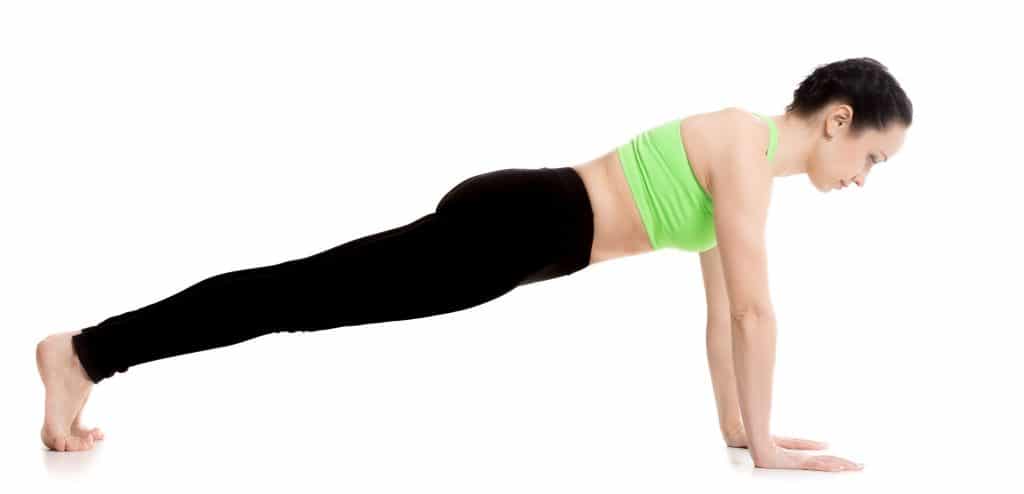Yoga has a number of incredible benefits, from decreasing stress and calming the mind to improving circulation and respiratory function. Many people think this ancient practice is all about meditation and flexibility, but it can actually be an extremely effective exercise for weight loss, and unlike a number of other fitness and slimming fads, it is extremely enjoyable and easy to stick to, which means you can keep the weight off!

Fights Stubborn Fat
The reason yoga is such an effective workout for weight loss is because it fights stubborn fat stores, especially as you age. There are a number of reasons for that, including strength and muscle development, lower stress levels, connection of the mind with the body, and overall happiness. By changing your mood and attitude and making you more aware of your body, yoga naturally encourages you to eat what you need to nourish your body, rather than for a sugar fix or pleasure. And because you are using your own body as weight, you will build strong, lean muscles all over, from your arms and core to your back and legs, increasing your metabolism and burning calories. And it’s not just Vinyasa or power yoga that has been proven to aid weight loss; a study out of the University of California found that even restorative yoga can be the perfect option for some people, especially those who are starting out particularly unhealthy, weak or overweight.
Sun Salutations
The traditional sun salutation (surya namaskar) is one of the best flow sequences to get your heart rate up, your whole body working and your circulation, metabolism and digestion kick started. It’s a great way to start the morning before breakfast and is the perfect warm up to begin a weight loss sequence. Follow this easy video to make sure you practice your sun salutations correctly and safely.
[iframe id=”https://www.youtube.com/embed/73sjOu0g58M”]
And either after your sun salutation or later on in the day, these 6 poses create the perfect sequence for rapid and permanent weight loss. It is best to use them in a flow, but if you are short on time, you can pick some of your favorites out to get your daily dose…
Chair Pose (Utkatasana)

This strengthening posture works your thighs and buttocks (which is where you’ll feel it!), but, without realizing it, you will also be working your core, back, arms and calf muscles, so it’s a great pose for overall strength.
Start by standing up tall and straight with your feet and legs together, exhale and then inhale as you raise your arms above your head, palms facing in. As you breathe out again, sit back as if you’re going for a chair, making sure you can always see your toes in front of your knees. Once you’re in position, take note of where your shoulders are – if they’re somewhere up near your ears, relax and let them drop to their usual position while ensuring your arms remain strong.
Try to take 3 to 5 long breaths in this position before slowly straightening your legs. As you become stronger and fitter, you can increase the length of time you hold the pose and the number of sequence repetitions you do.
Warrior 2 (Virabhadrasana II)

Sticking with the legs as the focus, but continuing to strengthen the whole body, this powerful pose is fantastic for muscle formation, posture, confidence and overall strength.
Again, begin standing tall, this time with your legs hip distance apart and as you exhale, step one foot behind. Turn your back foot 90 degrees forward and keep your front foot pointing forward. The middle of your back foot should be in line with your front heel. Firm your thighs and bend your front knee on an exhale so that it is aligned with your ankle (not leaning to one side or dropping further in front). Again, check that your shoulders are not attempting to touch your ears and send one arm forward and the other backwards, strong and straight. As you practice this pose, you can try to improve it each time by widening the stance and working on getting the line you form with your arms and feet straighter, as if you’re wedged between two walls. Also work on very slightly dropping your tailbone to stop any major dip in your back. You should feel that this gentle adjustment will firm your core muscles, which means they are also working. Repeat on the other side.
Plank Variations

This one feels like it’s all about the arms, but when done correctly, it’s pretty much the best core strengthening and stomach flattening exercise you can do!
To move into plank from warrior 2, step your back foot forward again and move into a forward fold. Bend your knees and plant both hands firmly on the ground slightly in front of your feet. Step one foot back and then the other, standing on the balls of your feet and your hands, heels pushing back. Make sure your wrists are directly underneath your shoulders and your back is straight (not drooping down or folding upwards in a triangle shape). To achieve this, tighten your core and thigh muscles and make sure your buttocks is not pointing up. Remember to breathe during this strong posture and hold it for as long as you can. If you have weak or injured wrists, you can practice plank pose on your forearms instead of your hands.

Plank is usually used as part of a sequence in a yoga flow or sun salutation and there is an extremely beneficial move called chaturanga, which takes a lot of arm and core strength, so it’s best to work up to it by practicing plank for a few weeks first. To move through chaturanga, start in plank pose and then roll forward from the balls of your feet onto your toes and slowly begin to lower down until your arms are at a 90 degree angle, elbows by your side, always ensuring your core is engaged and your body is in a straight line (not dipping down or pointing up). Stop when you get to this point and try to hold the position for a few breaths, hovering slightly above the ground.
Side plank is another great variation of this fat busting, core and arm strengthening pose. Start in plank and then roll onto the outside of one foot with the other foot resting in line on top of it. Lift one arm to the sky and make sure the wrist of the supporting arm is directly underneath the shoulder. Lift your hip upwards to make the pose even stronger. Repeat on the other side.
Boat Pose (Navasana)

This is a great balance and core strengthening pose. Start sitting in staff pose (back straight, legs out in front), then bend your knees and rest your hands underneath them. Lift one leg and then the other so that your lower legs are parallel to the floor. Push your chest out and straighten your back (making sure you’re not rounding the back or straining the neck). If you can, release your hands and shoot them forward next to your legs. Remember to breathe! Once you build a bit of strength in this pose, you can also add some boat sit-ups to your flow. As you exhale, slowly straighten your legs and upper body out and towards the floor and hover, and then slowly move back up to boat pose on an inhale using your core strength. You can also try straightening your legs upwards when you’re a bit stronger, instead of having bent knees, so that you’re in a V shape during navasana.
Tree Pose (Vrksasana)

Standing balance exercises are a great way to finish a weight loss yoga flow because you will already be quite warm and your body will be in calorie burning mode. Balancing takes an enormous amount of strength, which is something people often don’t realize. It takes just about every muscle in your body to stand in a difficult balancing position, especially the core.
For tree pose, start by standing up tall and straight in mountain pose (tadasana), tailbone slightly pointed down to lengthen the spine, knee caps lifted and thighs strong. Bring your attention to one of your feet and make sure you feel grounded on it – lift and spread your toes and roll from the balls of your feet to the heels if that helps flatten them out. Slowly lift the other foot and rest it on the calf muscle of your standing leg and stare at a still focus point ahead of you on the ground or wall. If you can, you can lift your leg higher and rest your foot on your inner thigh, but make sure you never rest it on your knee because you don’t want to put any strain on that important joint. You can rest your hands on your hips or lift them above your head. Make sure your back is straight during this posture and, as always, remember to breathe! Repeat with the opposite leg.
Warrior 3 (Virabhadrasana III)

This is another pose that involves a bit of practice and build up. It takes a lot of core, back and leg strength as well as balance.
When you feel ready to try Warrior 3 at the end of your weight loss yoga flow, come back to standing position after tree pose. The best way to start practicing Warrior 3 is to bend over into a forward fold (uttanasana), hands on the floor and send one leg backwards. Lift the leg so that it’s in a straight line with your back, and if your hip has opened towards the side (which it probably will have), gently try to turn it to face downwards so that both hips are aligned. When you feel balanced enough, you can lift your arms up and shoot them forward so that you’re making one long line. Repeat on the other side.
Restorative Poses
At the end of any yoga flow sequence, it’s a good idea to do some restorative poses to wind down. Start by lying on your back, knees bent and feet planted firmly on the floor. During an inhale, slowly lift your lower back and middle back off the ground, fold your shoulders under to open and stretch your chest, and clasp your hands underneath your back for bridge pose. Take a few breaths before slowly coming back down on an exhale and straighten out your legs. Next, lift your legs up to the sky, knees as straight as possible and toes pointing towards your face. Take a few breaths and slowly lower your legs on an exhale.
After L shape, take a universal spinal twist. Lie on your back with your arms stretched out to either side and lift one leg, letting the knee gently drop and rest over the other leg while both shoulders remain glued to the ground. Turn your gaze to the opposite hand and you should feel a nice stretch along your spine and side. Repeat with the other leg and then relax back into corpse pose (savasana) – laying flat on your back, legs apart and feet flopping to either side, palms facing up. Take a few breaths while resting in this pose.
Slowly sit back up when you’re ready, and you should feel refreshed, awake, stretched, healthy and strong, which is why it’s a great idea to practice yoga in the morning. That way, you start the day feeling great, which sets you up for a happy, healthy day!

Original article and pictures take bembu.com site
Комментариев нет:
Отправить комментарий